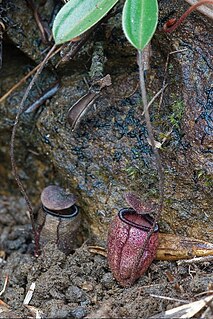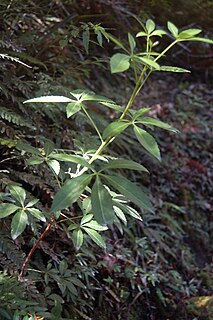
The Ericaceae are a family of flowering plants, commonly known as the heath or heather family, found most commonly in acid and infertile growing conditions. The family is large, with c. 4250 known species spread across 124 genera, making it the 14th most species-rich family of flowering plants. The many well-known and economically important members of the Ericaceae include the cranberry, blueberry, huckleberry, rhododendron, and various common heaths and heathers.

In biology, a subgenus is a taxonomic rank directly below genus.

Ledum was a genus in the family Ericaceae, including 8 species of evergreen shrubs native to cool temperate and subarctic regions of the Northern Hemisphere and commonly known as Labrador tea. It is now recognised as a subsection of section Rhododendron, subgenus Rhododendron, of the genus Rhododendron.

Nepenthes argentii is a highland Nepenthes pitcher plant native to Mount Guiting-Guiting on Sibuyan Island in the Philippines. It is possibly the smallest species in the genus and does not appear to have a climbing stage.

Rhododendron subg. Hymenanthes is a subgenus of the genus Rhododendron, with a widespread distribution in the temperate Northern Hemisphere. The species are evergreen shrubs and small to medium-sized trees, with medium-sized to large leaves. The flowers are large, produced in terminal trusses of 5-40 together.

Rhododendron ponticum, called common rhododendron or pontic rhododendron, is a species of Rhododendron native to southern Europe and southwest Asia.

Rhododendron maximum — its common names include great laurel, great rhododendron, rosebay rhododendron, American rhododendron and big rhododendron — is a species of Rhododendron native to the Appalachians of eastern North America, from Alabama north to coastal Nova Scotia.

Rhododendron spinuliferum is a species of Rhododendron native to Yunnan, southwestern Sichuan, and Guizhou China.

Raukaua is a genus of flowering plants in the family Araliaceae. It has an austral distribution, being indigenous to southern Argentina and Chile, as well as New Zealand and the island of Tasmania.
Rhododendron album is a species of plant in the Ericaceae family. It is endemic to Java in Indonesia. It is a vulnerable species threatened by habitat loss.

Rhododendron arboreum, the tree rhododendron, also known as Burans or Laligurans or simply Gurans in Nepal, is an evergreen shrub or small tree with a showy display of bright red flowers. It is found in Bhutan, China, India, Myanmar, Nepal, Sri Lanka, Pakistan and Thailand. Rhododendron arboreum is the national flower of Nepal; in India it is the state tree of Uttarakhand and state flower of Nagaland.

Rhododendron section Tsutsusi was a subgenus of the genus Rhododendron, commonly referred to as the evergreen azaleas. In 2005 it was reduced to a section of subgenus Azaleastrum. Containing 80 - 117 species, it includes both deciduous and evergreen types and is distributed in Japan, China and northeastern Asia. They are of high cultural importance to the Japanese. Among the species in this genus lie the largest flowering azaleas.

Rhododendron periclymenoides, commonly called pink azalea and pinxter flower, is a species of shrub in the heath family. It is native to eastern North America, where it is widespread from Alabama to New Hampshire. It is often found in riparian areas, in wet to dry forests.

Rhododendron section Vireya (vireyas) is a tropical group of Rhododendron species, numbering about 300 in all. Vireyas are native to southeastern Asia and range from Thailand to Australia.

Rhododendron subgenus Azaleastrum is a subgenus of the genus Rhododendron.

Rhododendron subsection Brachycalyx is a subsection of the genus Rhododendron, in section Tsutsusi, subgenus Azaleastrum, consisting of fifteen species of Azaleas from Asia.

Rhododendron subsection Tsutsusi is a subsection of the genus Rhododendron, in section Tsutsusi, subgenus Azaleastrum, consisting of 66 species of Azaleas.

North American azaleas are flowering shrubs in the genus Rhododendron, section Pentanthera, subsection Pentanthera, so named because they all have five stamens. Most are in the United States, with one species found in Canada and one being found in Mexico. North American azaleas are commonly confused with azaleas of Asian origin, the evergreen azaleas. North American azaleas are deciduous and produce two types of buds. One is a larger and produces about 20 flowers while the other bud produces a leafy shoot. The flower color, fragrance, and number of stamens vary among species.

In computing, a digital object identifier (DOI) is a persistent identifier or handle used to identify objects uniquely, standardized by the International Organization for Standardization (ISO). An implementation of the Handle System, DOIs are in wide use mainly to identify academic, professional, and government information, such as journal articles, research reports and data sets, and official publications though they also have been used to identify other types of information resources, such as commercial videos.

JSTOR is a digital library founded in 1995. Originally containing digitized back issues of academic journals, it now also includes books and other primary sources, and current issues of journals. It provides full-text searches of almost 2,000 journals. As of 2013, more than 8,000 institutions in more than 160 countries had access to JSTOR; most access is by subscription, but some of the site's public domain and open access content is available at no cost to anyone. JSTOR's revenue was $86 million in 2015.




















